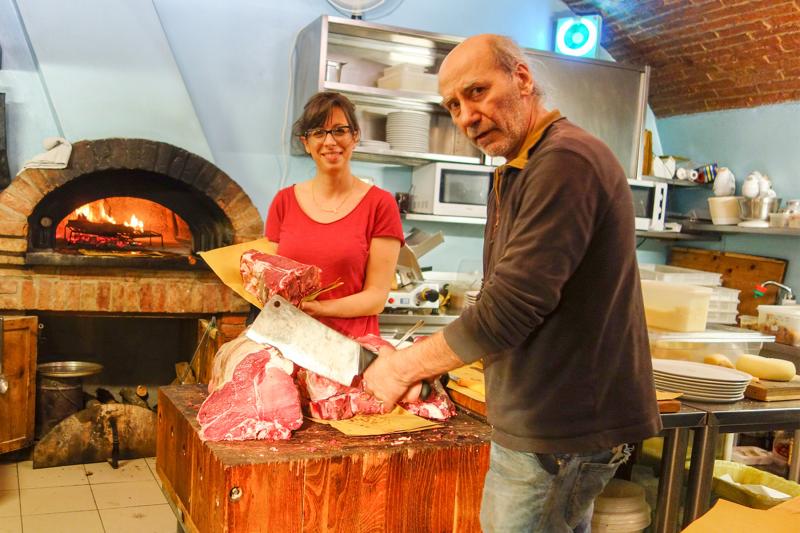Rick Steves’ Europe: The Italian love of eating
Appears in the Online Edition, December 2020.
As we’ve had to postpone our travels because of the pandemic, I believe a weekly dose of travel dreaming can be good medicine. Here’s one of my favorite European memories. And, like so many, it involves eating in Italy — a reminder of the delicious experiences that await us at the other end of this crisis.
Spending a month in Italy, the thought of eating anything other than Italian food never occurs to me. Other than France, I doubt there’s another country in Europe that could hold my palate’s interest so completely. One reason I don’t tire of going local here is that this land of a thousand bell towers is also the land of a thousand regional cuisines. And I celebrate each region’s forte.
Tuscany is proud of its beef, so I seek out a place to sink my teeth into a carnivore’s dream. My favorite steakhouse is in Montepulciano. The scene in a stony cellar, under one long, rustic vault, is powered by an open fire in the far back. Flickering in front of the flames is a gurney, upon which lays a hunk of beef the size of a small human corpse. Like a blacksmith in hell, Giulio — a lanky, George Carlin lookalike in a T-shirt — hacks at the beef, lopping off a steak every few minutes. He gets an order and then it’s whop! ... leave it to cleaver.
In a kind of mouthwatering tango, he prances past boisterous tables of eaters, holding above the commotion the raw slabs of beef on butcher paper. Giulio presents the slabs to my friends and me, telling us the weight and price and getting our permission to cook it. He then dances back to the inferno and cooks the slabs: seven minutes on one side, seven on the other. There’s no asking how you’d like it done; this is the way it is done. Seven minutes on one side, seven on the other… fifteen minutes later, we get our steaks.
In Italy, the cuisine is revered — and the quality of the ingredients is sacred. While French cuisine is famously enthusiastic about the sauces, for Italians, sauces highlight the delightful flavor of their favorite seasonal ingredients. Italians like to say, “La miglior cucina comincia dal mercato.” (“The best cuisine starts from the market.”) They care deeply about what’s in season and what’s grown locally.
One night in Florence, I’m dining with my friend Cincia at her favorite trattoria when the chef comes out to chat with her. They get into an animated debate about the ingredients: “Arugula is not yet in season. But oh, Signora Maria has more sun in her backyard, and her chickens give her a marvelous fertilizer.”
Then the topic changes to the cuisine turmoil caused by erratic weather. Vignarola, the beloved stew consisting of artichokes, peas, and fava beans, is on the menu before its normal season. Cincia, seeming traumatized, says, “Vignarola, how can it be served so early? I’ve never seen it on a menu before Easter.” The chef, who only makes it for a few weeks each spring during a perfect storm of seasonality when everything is bursting with flavor, has to convince her that the season has changed and it’s on the menu because this is the new season.
Enjoying the commotion, I explain to Cincia that this is the kind of restaurant I seek out in Italy. It ticks all the boxes: It’s personality-driven — a mom-and-pop place — and run by people enthusiastic about sharing their love of good cooking. It’s a low-rent location, with lots of locals. The menu is small because they’re selling everything they’re cooking. It’s in one language, Italian, because they cater to locals rather than tourists. And it’s handwritten because it’s shaped by what’s fresh in the market today. I tell her, “We have fine Italian restaurants in America, but even the finest cannot create the energy and ambiance that comes with simply being in Italy.”
Cincia then takes control, telling me to put away my notepad and stop being a travel writer. She says, “Only a tourist would rush a grappa or pull the fat off the prosciutto. Tonight, we eat with no notes. We eat my way.” Reviewing the options, she pours me another drink and suggests that I totally relax. Then she turns to the chef and says simply, “Mi faccia felice” (Make me happy).
He does. And that night, along with enjoying a great meal, I added a new favorite word to my Italian vocabulary: indimenticabile (unforgettable).
(Rick Steves (www.ricksteves.com) writes European guidebooks, hosts travel shows on public TV and radio, and organizes European tours. This article was adapted from his new book, For the Love of Europe. You can email Rick at rick@ricksteves.com and follow his blog on Facebook.)

